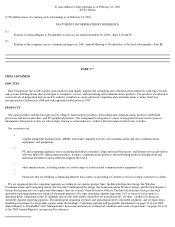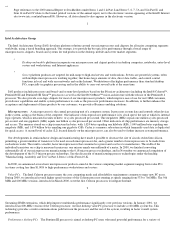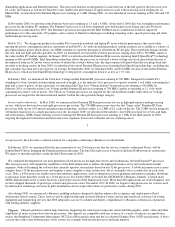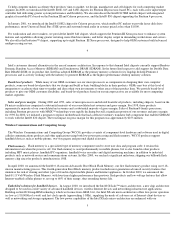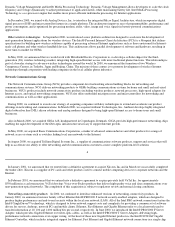Intel 2000 Annual Report Download - page 13
Download and view the complete annual report
Please find page 13 of the 2000 Intel annual report below. You can navigate through the pages in the report by either clicking on the pages listed below, or by using the keyword search tool below to find specific information within the annual report.
Intellectual property rights that apply to our various products include patents, copyrights, trade secrets, trademarks and maskwork rights.
Intel has established an active program to protect its investment in technology by enforcing its intellectual property rights. We do not intend to
license our intellectual property rights broadly unless we can obtain adequate consideration. We also refer to information appearing under the
heading "Competition" in Part I, Item 1 of this Form 10-K.
We have filed and obtained a number of patents in the United States and abroad, and we have entered into patent cross-license agreements
with many of our major competitors and other parties. While our intellectual property rights are important to our success, our business as a
whole is not materially dependent upon any particular patent or license. We and other companies in the computer, telecommunications and
related high-technology fields typically apply for and receive, in the aggregate, thousands of patents annually in the United States and other
countries. In addition, because of the fast pace of innovation and product development, our products are often obsolete before the patents
related to them expire. As a result, we believe that the duration of the applicable patents is adequate relative to the expected lives of our
products.
We protect many of our computer programs by copyrighting them. We have registered numerous copyrights with the United States
Copyright Office. The ability to protect or copyright software in some foreign jurisdictions is not clear. However, it is our policy to require
customers to obtain a software license contract before we provide them with certain computer programs. Certain components contain
embedded computer programs, and we have also obtained copyright protection for some of these programs. In addition, we have obtained
protection for the maskworks for a number of our components under the Chip Protection Act of 1984.
We have obtained certain trademarks and trade names for our products to distinguish genuine Intel products from our competitors' products,
and we are currently engaged in a cooperative program with OEMs to identify with the Intel Inside® logo certain personal computers
containing genuine Intel microprocessors. We maintain certain details about our processes, products and strategies as trade secrets.
Like many companies in the semiconductor and other high-technology industries, we have from time to time been notified of claims that we
may be infringing certain intellectual property rights of others. These claims have been referred to counsel, and they are in various stages of
evaluation and negotiation. If it appears necessary or desirable, we may seek licenses for these intellectual property rights. We can give no
assurance that licenses will be offered by all claimants, that the terms of any offered licenses will be acceptable to us or that in all cases the
dispute will be resolved without litigation, which may be time consuming and expensive, and may result in injunctive relief or the payment of
damages by us. We also refer to the information appearing under the heading "Legal Proceedings" in Part I, Item 3 of this Form 10-K.
COMPLIANCE WITH ENVIRONMENTAL REGULATIONS
To our present knowledge, compliance with federal, state and local provisions enacted or adopted for protection of the environment has had
no material effect upon our operations. Reference is made to the information appearing under the heading "Legal Proceedings" in Part I, Item 3
of this Form 10-K.
15
EXECUTIVE OFFICERS
The following sets forth certain information with regard to executive officers of Intel (ages are as of December 30, 2000):
Craig R. Barrett (age 61) has been a director of Intel since 1992, Chief Executive Officer since 1998 and President since 1997. Prior to that,
Dr. Barrett was Chief Operating Officer from 1993 to 1998 and Executive Vice President from 1990 to 1997.
Andrew S. Grove (age 64) has been a director of Intel since 1974 and Chairman of the Board since 1997. Dr. Grove was Chief Executive
Officer from 1987 to 1998 and President from 1979 to 1997.
Gordon E. Moore (age 71) has been a director of Intel since 1968 and Chairman Emeritus of the Board since 1997. Prior to that, Dr. Moore
was Chairman of the Board from 1979 to 1997.
Leslie L. Vadasz (age 64) has been a director of Intel since 1988 and Executive Vice President and President, Intel Capital, since
January 2000. Prior to that, Mr. Vadasz was Senior Vice President and Director of Corporate Business Development from 1991 to
January 2000.
Paul S. Otellini (age 50) has been Executive Vice President and General Manager, Intel Architecture Group, since 1998. Prior to that,
Mr. Otellini was Executive Vice President and Director, Sales and Marketing Group, from 1996 to 1998, and Senior Vice President and
Director, Sales and Marketing Group, from 1994 to 1996.
Gerhard H. Parker (age 57) has been Executive Vice President and General Manager, New Business Group, since 1998. Prior to that,
Dr. Parker was Executive Vice President and General Manager, Technology and Manufacturing Group, from 1996 to 1998, and Senior Vice


